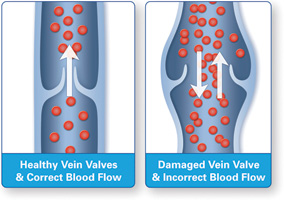Contact us today.
Chronic Vein Disease Explained
What is Chronic Vein Disease (CVD)?
 Chronic venous insufficiency (CVI) occurs when the valves in the leg veins are not working properly, causing blood to collect in the veins rather than return to the heart. This is called stasis.
Chronic venous insufficiency (CVI) occurs when the valves in the leg veins are not working properly, causing blood to collect in the veins rather than return to the heart. This is called stasis.
Healthy veins contain valves which open and close to keep the blood moving in the right direction. Problems develop when some of those valves become damaged and stop working. This results in backward flow (“reflux”) of blood in the veins, and a slower drainage of the used blood from your legs. This is called Chronic Venous Disease (CVD).
What are the symptoms of Chronic Venous Disease?
Common signs of CVD in the legs include swelling, fatigue, pain, large visible veins, and in advanced cases, skin color changes, and even poorly healing wounds (ulceration’s).
- Leg pain
- Leg discomfort (itching/cramping/restless legs/heaviness)
- Leg fatigue
- Spider Veins
- Varicose Veins
- Swelling/ “Edema”
- Skin changes/ “Stasis Dermatitis”
- Ulceration
Who is at risk?
As much as 40 percent of people in the United States are estimated to have CVI. Some risk factors for CVD are genetic. These include family history, sex, and age. Risk increases for people over age 50 and the disease occurs more often in Women than Men. Other risk factors can be controlled. These include obesity, pregnancy, having a job that requires prolonged sitting or standing, injury, surgery, and blood clots.
- Family History
- Sex (Females have more risk)
- Age (Risk increases with age)
- Obesity
- Pregnancy
- Prolonged standing or sitting
- Prior injury or surgery
- History of blood clot
How is CVD treated?
The first step in management is an accurate diagnosis performed by a trained professional using non-invasive doppler ultrasound. Following diagnosis most insurance will require a trial of conservative measures like wearing medical grade compression stockings / hose. If the problem is not improved, minimally-invasive procedures, performed in the comfort of our office may be needed.
Treatment Overview:
- Conservative measures
- Radiofrequency (RF) Ablation
- Endovenous Laser Treatment (EVLT)
- Ultrasound Guided Foam Sclerotherapy (USGS)
- Microphlebectomy
- Visual Sclerotherapy
- Angie Thermocoagulation

